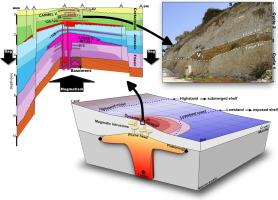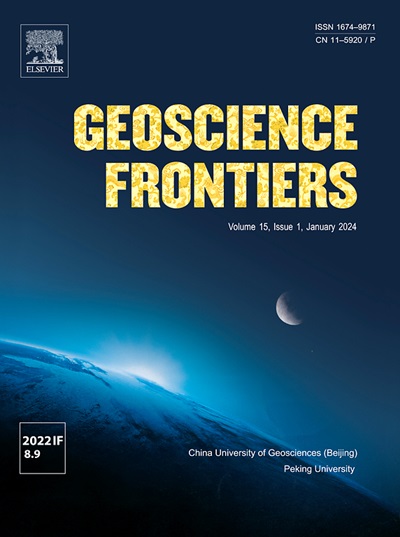火山-沉积对地幔柱衰变的响应:地中海东部边缘的一个案例研究
IF 8.9
1区 地球科学
Q1 GEOSCIENCES, MULTIDISCIPLINARY
引用次数: 0
摘要
地幔柱衰变的特征是岩浆活动的减少、局部火山脉冲和短期地形波动。这些过程在海洋环境中比在陆地环境中保存得更好,提供了更清晰的地表动力学记录。本研究通过分析反复出现的火山活动和垂直运动对卡梅尔火山-沉积地层学的影响,考察了地中海-塞诺曼尼亚时期黎凡特地幔柱的衰变。卡梅尔火山位于地中海大陆东部边缘,是一个天然气巨省。地质填图和40Ar/39Ar测年显示了4个不同的火山脉冲(V1-V4),介于~ 99 Ma和95.4 Ma之间,每个脉冲都与地表隆起有关,然后是沉降和沉积。这些循环表明压力的积累和释放可能是由残余羽状柱相关的岩浆活动驱动的,而不是由区域构造驱动的。火山活动、垂直运动和浅海区域形成了与海洋有不同联系的局部盆地,形成了以白垩、石灰岩、白云岩、泥灰岩和凝灰岩等岩性为特征的多样化沉积环境。火山构造影响了相变化,促进了浅层部分封闭海洋环境白云岩的形成。最后一次脉冲是82 Ma的V5,发生在13 Myr的静止之后,标志着区域构造环境的转变。缺乏后马斯特里赫特火山活动和25迈的长期沉降表明羽流终止。这些发现证明了衰变的羽流是如何失去影响地表动力学的能力的。位于阿拉伯平台边缘的长期地壳高构造块(膨胀)顶部的阿尔比安-图尔onian珊瑚礁是世界范围内类似的一个重要例子。本文章由计算机程序翻译,如有差异,请以英文原文为准。

Volcano-sedimentary response to a mantle plume decay: A case study from the Eastern Mediterranean margin
The decay of a mantle plume is characterized by a decline in magmatic activity, localized volcanic pulses, and short-term topographic fluctuations. These processes are better preserved in marine settings than on land, offering a clearer record of surface dynamics. This study examines the decay of the Levant mantle plume during the Albian-Cenomanian by analyzing the effect of recurring volcanism and vertical motions on the volcano-sedimentary stratigraphy exposed in Mt. Carmel, located on the eastern Mediterranean continental margin, a gas giant province. Geological mapping and 40Ar/39Ar dating reveal four distinct volcanic pulses (V1–V4) between ∼99 Ma and 95.4 Ma, each associated with surface uplift followed by subsidence and sedimentation. These cycles suggest pressure accumulation and release, likely driven by residual plume-related magmatic activity rather than regional tectonics. Volcanism, vertical motions, and shallow marine areas created local basins with varying connections to the sea, resulting in diverse depositional environments characterized by lithologies such as chalk, limestone, dolomite, marl, and tuff. The volcanic structures influenced facies changes and contributed to the formation of dolomite in shallow, partially closed marine environments. A final pulse, V5 at 82 Ma, occurred after 13 Myr of quiescence, marking a shift in the regional tectonic setting. The lack of post-Maastrichtian volcanism and a 25 Myr long period of subsidence indicate plume termination. These findings demonstrate how a decaying plume loses its ability to influence surface dynamics. The Albian-Turonian reefs, situated atop a long-lasting crustal high structural block (swell) at the Arabian platform’s edge, serve as a significant example for analogous worldwide.
求助全文
通过发布文献求助,成功后即可免费获取论文全文。
去求助
来源期刊

Geoscience frontiers
Earth and Planetary Sciences-General Earth and Planetary Sciences
CiteScore
17.80
自引率
3.40%
发文量
147
审稿时长
35 days
期刊介绍:
Geoscience Frontiers (GSF) is the Journal of China University of Geosciences (Beijing) and Peking University. It publishes peer-reviewed research articles and reviews in interdisciplinary fields of Earth and Planetary Sciences. GSF covers various research areas including petrology and geochemistry, lithospheric architecture and mantle dynamics, global tectonics, economic geology and fuel exploration, geophysics, stratigraphy and paleontology, environmental and engineering geology, astrogeology, and the nexus of resources-energy-emissions-climate under Sustainable Development Goals. The journal aims to bridge innovative, provocative, and challenging concepts and models in these fields, providing insights on correlations and evolution.
 求助内容:
求助内容: 应助结果提醒方式:
应助结果提醒方式:


